Lunar Orbiter 2 launched
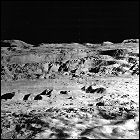 The second in NASA’s series of Lunar Orbiter satellites lifts off from Earth on a course for the moon. Lunar Orbiter 2 spends a full week examining the surface of the moon from orbit, sending back high-resolution TV images for mapping purposes, and to help NASA scientists and engineers select suitable landing sites for the upcoming Apollo program. Lunar Orbiter 2’s orbital path allows it to image a particularly promising plain in the Sea of Tranquility…
The second in NASA’s series of Lunar Orbiter satellites lifts off from Earth on a course for the moon. Lunar Orbiter 2 spends a full week examining the surface of the moon from orbit, sending back high-resolution TV images for mapping purposes, and to help NASA scientists and engineers select suitable landing sites for the upcoming Apollo program. Lunar Orbiter 2’s orbital path allows it to image a particularly promising plain in the Sea of Tranquility…

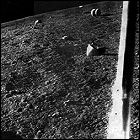 The Soviet Union launches unmanned space probe Luna 13 toward the moon, where it becomes the third space vehicle to successfully make a soft landing on the lunar surface. Larger than its Soviet predecessor, Luna 9, Luna 13 measures the temperature, radiation, and hardness of the moon’s surface, all useful information to have in advance of a manned landing. After operating on the lunar surface for four days, the Luna 13 lander’s batteries are exhausted and the mission is over.
The Soviet Union launches unmanned space probe Luna 13 toward the moon, where it becomes the third space vehicle to successfully make a soft landing on the lunar surface. Larger than its Soviet predecessor, Luna 9, Luna 13 measures the temperature, radiation, and hardness of the moon’s surface, all useful information to have in advance of a manned landing. After operating on the lunar surface for four days, the Luna 13 lander’s batteries are exhausted and the mission is over.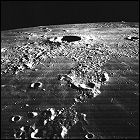 The third of five Lunar Orbiter satellites is launched to the moon by NASA, and once in orbit,
The third of five Lunar Orbiter satellites is launched to the moon by NASA, and once in orbit, 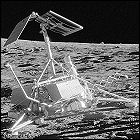 NASA’s robotic explorer
NASA’s robotic explorer 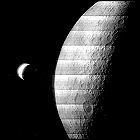 NASA’s fourth Lunar Orbiter satellite lifts off for its one-week trek to the moon. Placed into an orbit that takes it over the moon’s poles instead of its equator,
NASA’s fourth Lunar Orbiter satellite lifts off for its one-week trek to the moon. Placed into an orbit that takes it over the moon’s poles instead of its equator, 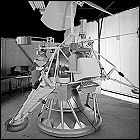 For the second time, one of NASA’s robotic Surveyor space probes fails to make it to the moon intact. Launched three days before,
For the second time, one of NASA’s robotic Surveyor space probes fails to make it to the moon intact. Launched three days before, 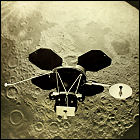 NASA’s final Lunar Orbiter satellite is sent to the moon, with a goal of completing the mapping of the moon’s surface left unfinished by mechanical issues with its predecessor. Lunar Orbiter 5 completes the mapping of the lunar far side and helps engineers and scientists determine signal coverage from the Earth-based tracking stations that will help NASA stay in contact with future Apollo missions to the moon.
NASA’s final Lunar Orbiter satellite is sent to the moon, with a goal of completing the mapping of the moon’s surface left unfinished by mechanical issues with its predecessor. Lunar Orbiter 5 completes the mapping of the lunar far side and helps engineers and scientists determine signal coverage from the Earth-based tracking stations that will help NASA stay in contact with future Apollo missions to the moon.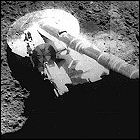 Despite an in-flight fuel pressure glitch that threatens to make this the third failure for the Surveyor program,
Despite an in-flight fuel pressure glitch that threatens to make this the third failure for the Surveyor program, 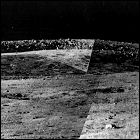 NASA’s robotic explorer
NASA’s robotic explorer 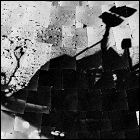
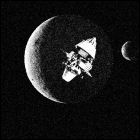 The Soviet Union launches unmanned space probe Luna 14 toward the moon, where it takes up a lunar orbit and returns scientific data on cosmic rays and gravitational variances. This is the last orbital mission of the Luna series; future Luna vehicles will be landers or landers with rovers, some with sample return capability.
The Soviet Union launches unmanned space probe Luna 14 toward the moon, where it takes up a lunar orbit and returns scientific data on cosmic rays and gravitational variances. This is the last orbital mission of the Luna series; future Luna vehicles will be landers or landers with rovers, some with sample return capability.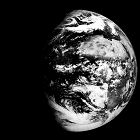 The Soviet Union launches Zond 5, a Soyuz 7K-L1 command & service module intended for flight around the moon. Rather than a cosmonaut crew, however, Zond 5 has biological specimens on board, including insects, plants, bacteria, and a pair of turtles – the first living creatures from Earth to orbit the moon. The specimens are all returned safely, though Zond 5 is the second consecutive Zond flight to lose attitude control after re-entry, splashing down in the Indian Ocean rather than making the customary propulsive return to Soviet soil. American intelligence agencies are aware of the mostly successful flight, and NASA alters the Apollo manned flight schedule to attempt to put men in orbit of the moon by the end of 1968.
The Soviet Union launches Zond 5, a Soyuz 7K-L1 command & service module intended for flight around the moon. Rather than a cosmonaut crew, however, Zond 5 has biological specimens on board, including insects, plants, bacteria, and a pair of turtles – the first living creatures from Earth to orbit the moon. The specimens are all returned safely, though Zond 5 is the second consecutive Zond flight to lose attitude control after re-entry, splashing down in the Indian Ocean rather than making the customary propulsive return to Soviet soil. American intelligence agencies are aware of the mostly successful flight, and NASA alters the Apollo manned flight schedule to attempt to put men in orbit of the moon by the end of 1968.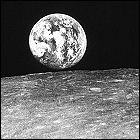 The Soviet Union launches an unmanned Soyuz 7K-L1 spacecraft, designated Zond 6, on a seven-day flight around the moon and back to Earth. Like Zond 5 before it, Zond 6 carries specimens of Earth animals and plants, but a rupture of the Soyuz pressure vessel results in these specimens being exposed to hard vacuum, resulting in instant death. Furthermore, the spacecraft opens and jettisons its parachutes too early, leaving it to slam into the ground at high speed. With continued glitches plaguing the Zond flights, Soviet mission planners aren’t confident enough in the 7K-L1 capsule to put cosmonauts in it for the next flight.
The Soviet Union launches an unmanned Soyuz 7K-L1 spacecraft, designated Zond 6, on a seven-day flight around the moon and back to Earth. Like Zond 5 before it, Zond 6 carries specimens of Earth animals and plants, but a rupture of the Soyuz pressure vessel results in these specimens being exposed to hard vacuum, resulting in instant death. Furthermore, the spacecraft opens and jettisons its parachutes too early, leaving it to slam into the ground at high speed. With continued glitches plaguing the Zond flights, Soviet mission planners aren’t confident enough in the 7K-L1 capsule to put cosmonauts in it for the next flight.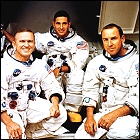 Moved ahead in the schedule due to ongoing difficulties with the construction of the lunar module, Apollo 8 lifts off from Cape Canaveral on a mission that represents NASA’s biggest gamble yet in the race for the moon: on only the second manned Apollo flight, astronauts Frank Borman, Jim Lovell and Bill Anders will go to the moon, orbit it in their command/service module, and return to Earth (the lunar module is still in the late stages of development). Mission planners plot out a free return trajectory – ensuring that without engines, Apollo 8 could loop around behind the moon and swing back toward home.
Moved ahead in the schedule due to ongoing difficulties with the construction of the lunar module, Apollo 8 lifts off from Cape Canaveral on a mission that represents NASA’s biggest gamble yet in the race for the moon: on only the second manned Apollo flight, astronauts Frank Borman, Jim Lovell and Bill Anders will go to the moon, orbit it in their command/service module, and return to Earth (the lunar module is still in the late stages of development). Mission planners plot out a free return trajectory – ensuring that without engines, Apollo 8 could loop around behind the moon and swing back toward home.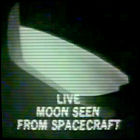 Broadcasting live black & white television pictures from lunar orbit on Christmas Eve, the crew of Apollo 8 delivers one of the most-watched broadcasts of 1968. As the surface of the moon rolls silently outside the windows of their command/service module, the astronauts take turns reading the first chapter of Genesis, dedicating it to “all of you on the good Earth.” After ten orbits of the moon, Apollo 8 fires its engine, putting it on a return trajectory to Earth; it splashes down safely three days later.
Broadcasting live black & white television pictures from lunar orbit on Christmas Eve, the crew of Apollo 8 delivers one of the most-watched broadcasts of 1968. As the surface of the moon rolls silently outside the windows of their command/service module, the astronauts take turns reading the first chapter of Genesis, dedicating it to “all of you on the good Earth.” After ten orbits of the moon, Apollo 8 fires its engine, putting it on a return trajectory to Earth; it splashes down safely three days later.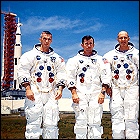 Apollo 10 lifts off for a dress rehearsal over the moon. Thomas Stafford, Gene Cernan and John Young fly a complete Apollo stack – both the command/service module and the lunar model – to the moon, conducting practice maneuvers in lunar orbit. Over eight days, the Apollo 10 crew does everything but land on the moon. With the mission requirements fulfilled, NASA announces that the next Apollo mission will attempt an actual landing.
Apollo 10 lifts off for a dress rehearsal over the moon. Thomas Stafford, Gene Cernan and John Young fly a complete Apollo stack – both the command/service module and the lunar model – to the moon, conducting practice maneuvers in lunar orbit. Over eight days, the Apollo 10 crew does everything but land on the moon. With the mission requirements fulfilled, NASA announces that the next Apollo mission will attempt an actual landing.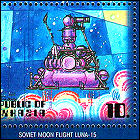 The Soviet Union launches unmanned space probe Luna 15 toward the moon, the Soviet space program’s last attempt to claim a victory in the race to the moon. Intended to land on the moon and gather a core sample of lunar soil which will then be rocketed back to Earth, hopefully ahead of the arrival of lunar soil samples from the concurrent American Apollo 11 moon landing attempt, Luna 15’s lander detaches and attempts its landing on July 20th…only to crash into the moon’s surface, losing all contact with Earth, while NASA astronauts Neil Armstrong and Buzz Aldrin prepare to depart with their soil samples intact. In a rare display of international cooperation, the Soviets shared basic orbital parameters of Luna 15’s flight with NASA to avoid any navigational hazards for Apollo 11.
The Soviet Union launches unmanned space probe Luna 15 toward the moon, the Soviet space program’s last attempt to claim a victory in the race to the moon. Intended to land on the moon and gather a core sample of lunar soil which will then be rocketed back to Earth, hopefully ahead of the arrival of lunar soil samples from the concurrent American Apollo 11 moon landing attempt, Luna 15’s lander detaches and attempts its landing on July 20th…only to crash into the moon’s surface, losing all contact with Earth, while NASA astronauts Neil Armstrong and Buzz Aldrin prepare to depart with their soil samples intact. In a rare display of international cooperation, the Soviets shared basic orbital parameters of Luna 15’s flight with NASA to avoid any navigational hazards for Apollo 11.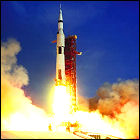 Apollo 11 lifts off, with astronauts Neil Armstrong, Buzz Aldrin and Michael Collins aboard. This is the first mission scheduled to attempt a landing on the moon, with Armstrong and Aldrin aboard the lunar module while Collins remains in orbit in the command/service module.
Apollo 11 lifts off, with astronauts Neil Armstrong, Buzz Aldrin and Michael Collins aboard. This is the first mission scheduled to attempt a landing on the moon, with Armstrong and Aldrin aboard the lunar module while Collins remains in orbit in the command/service module.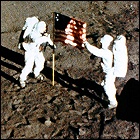 The Apollo 11 lunar module touches down in the Sea of Tranquility, a flat plain on the moon. Astronaut Neil Armstrong is the first human being to set foot on another body in the solar system, followed by “Buzz” Aldrin; the two spend roughly two and a half hours on the moon and gather nearly 50 pounds of samples of lunar soil and rock. This feat effectively ends the Cold War space race, though both the United States and the Soviet Union continue their lunar efforts: more Apollo missions are still on the schedule, and the Soviet continue trying to mount a successful launch of their giant N1 rocket.
The Apollo 11 lunar module touches down in the Sea of Tranquility, a flat plain on the moon. Astronaut Neil Armstrong is the first human being to set foot on another body in the solar system, followed by “Buzz” Aldrin; the two spend roughly two and a half hours on the moon and gather nearly 50 pounds of samples of lunar soil and rock. This feat effectively ends the Cold War space race, though both the United States and the Soviet Union continue their lunar efforts: more Apollo missions are still on the schedule, and the Soviet continue trying to mount a successful launch of their giant N1 rocket.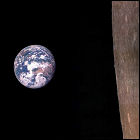 The Soviet Union launches the Zond 7 unmanned spacecraft, an unmanned version of the Soyuz 7K-L1 space vehicle intended to take cosmonauts around the moon. Carrying no crew, this vehicle takes pictures and tests various spacecraft systems without risking human lives. Zond 7 returns to Earth using an unusual multiple-skip atmospheric re-entry profile on August 14th. If Zond 7 had been carrying a crew, this would have been the first nominal flight of the Soyuz 7K-L1 vehicle. No cosmonaut crews would reach the moon prior to the dissolution of the Soviet Union in the late 20th century.
The Soviet Union launches the Zond 7 unmanned spacecraft, an unmanned version of the Soyuz 7K-L1 space vehicle intended to take cosmonauts around the moon. Carrying no crew, this vehicle takes pictures and tests various spacecraft systems without risking human lives. Zond 7 returns to Earth using an unusual multiple-skip atmospheric re-entry profile on August 14th. If Zond 7 had been carrying a crew, this would have been the first nominal flight of the Soyuz 7K-L1 vehicle. No cosmonaut crews would reach the moon prior to the dissolution of the Soviet Union in the late 20th century.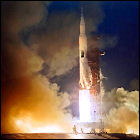 Apollo 12 lifts off, with astronauts Pete Conrad and Alan Bean set to become the next pair of human moonwalkers aboard the lunar module Intrepid, while Dick Gordon observes from orbit in the command/service module Yankee Clipper. The Intrepid crew is also assigned to deploy an instrument package called ALSEP (Apollo Lunar Scientific Experiment Package) which will be left on the surface even after their departure. The mission lasts ten days.
Apollo 12 lifts off, with astronauts Pete Conrad and Alan Bean set to become the next pair of human moonwalkers aboard the lunar module Intrepid, while Dick Gordon observes from orbit in the command/service module Yankee Clipper. The Intrepid crew is also assigned to deploy an instrument package called ALSEP (Apollo Lunar Scientific Experiment Package) which will be left on the surface even after their departure. The mission lasts ten days.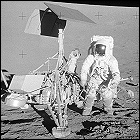 Astronauts Pete Conrad and Alan Bean land on the moon in the Apollo 12 lunar module Intrepid, a mere 600 feet away from the 1967 landing site of the unmanned Surveyor 3 probe. Pieces of Surveyor 3 are gathered for return to Earth to study the effects of prolonged exposure to the lunar environment. Conrad and Bean conduct two moonwalks, each lasting nearly four hours.
Astronauts Pete Conrad and Alan Bean land on the moon in the Apollo 12 lunar module Intrepid, a mere 600 feet away from the 1967 landing site of the unmanned Surveyor 3 probe. Pieces of Surveyor 3 are gathered for return to Earth to study the effects of prolonged exposure to the lunar environment. Conrad and Bean conduct two moonwalks, each lasting nearly four hours.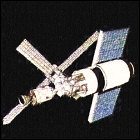 NASA formally cancels the planned Apollo 20 mission to the moon’s Copernicus crater in order to begin converting the upper stage of the mission’s Saturn V rocket into the Skylab space station, to be launched in the early 1970s. Construction of the Apollo command/service module and lunar module scheduled to fly this mission was halted before either vehicle was completed. The crew would have consisted of Stu Roosa, Paul Weitz and Jack Lousma; ironically, Weitz was transferred to the first Skylab crew, while Lousma was part of the second Skylab crew. Both later flew on shuttle missions.
NASA formally cancels the planned Apollo 20 mission to the moon’s Copernicus crater in order to begin converting the upper stage of the mission’s Saturn V rocket into the Skylab space station, to be launched in the early 1970s. Construction of the Apollo command/service module and lunar module scheduled to fly this mission was halted before either vehicle was completed. The crew would have consisted of Stu Roosa, Paul Weitz and Jack Lousma; ironically, Weitz was transferred to the first Skylab crew, while Lousma was part of the second Skylab crew. Both later flew on shuttle missions.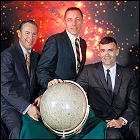 The third planned lunar landing mission, Apollo 13, lifts off. Astronauts Jim Lovell and Fred Haise are scheduled to walk in the Fra Mauro region of the moon. Command module pilot Ken Mattingly falls victim to a medical condition, leaving NASA to make a rare substitution, rotating the backup crew’s command module pilot, Jack Swigert, to the prime crew prior to launch.
The third planned lunar landing mission, Apollo 13, lifts off. Astronauts Jim Lovell and Fred Haise are scheduled to walk in the Fra Mauro region of the moon. Command module pilot Ken Mattingly falls victim to a medical condition, leaving NASA to make a rare substitution, rotating the backup crew’s command module pilot, Jack Swigert, to the prime crew prior to launch.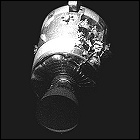 Halfway between Earth and the moon, a fuel cell rupture in the Apollo 13 service module causes a massive explosion. The crew has to activate the landing module, Aquarius, to use it as a “lifeboat”; the oxygen and power reserves of the command module, Odyssey, have been compromised by the explosion and must be preserved for re-entry. The crew endures extreme cold and must ration consumables to survive. Fortunately, there’s enough fuel in Aquarius’ descent stage to put the combined vehicle on a free-return trajectory, looping it around the far side of the moon for an immediate return to Earth.
Halfway between Earth and the moon, a fuel cell rupture in the Apollo 13 service module causes a massive explosion. The crew has to activate the landing module, Aquarius, to use it as a “lifeboat”; the oxygen and power reserves of the command module, Odyssey, have been compromised by the explosion and must be preserved for re-entry. The crew endures extreme cold and must ration consumables to survive. Fortunately, there’s enough fuel in Aquarius’ descent stage to put the combined vehicle on a free-return trajectory, looping it around the far side of the moon for an immediate return to Earth.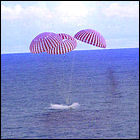 Having become the stuff of round-the-clock news coverage (though few media outlets bothered to cover any aspects of the mission before the emergency took place), the reactivated Apollo 13 command module Odyssey successfully reenters Earth’s atmosphere and returns its crew safely. (The lunar module, Aquarius, has been discarded in Earth orbit, where it eventually disintegrates, upon reentry; rather than landing on the moon, its fuel and air reserves have served the much more important function of keeping the crew alive.)
Having become the stuff of round-the-clock news coverage (though few media outlets bothered to cover any aspects of the mission before the emergency took place), the reactivated Apollo 13 command module Odyssey successfully reenters Earth’s atmosphere and returns its crew safely. (The lunar module, Aquarius, has been discarded in Earth orbit, where it eventually disintegrates, upon reentry; rather than landing on the moon, its fuel and air reserves have served the much more important function of keeping the crew alive.)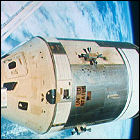 After the Congressional budget for the fiscal year of
After the Congressional budget for the fiscal year of 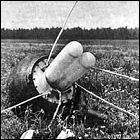 The Soviet Union launches unmanned space probe Luna 16 toward the moon, the first success in the Soviet space program’s ongoing attempt to mount a robotic sample return mission. The lander’s drill-equipped sample collection arm gathers a 35 millimeter, 100-gram core sample of lunar soil, which is then packed into a shielded return capsule for direct return to Earth (seen here after landing). Now claiming that they advocate robotic sample return missions without putting human lives at risk, the Soviets can at last claim a lunar first – the first robotic return to Earth of a soil sample from another body in the solar system.
The Soviet Union launches unmanned space probe Luna 16 toward the moon, the first success in the Soviet space program’s ongoing attempt to mount a robotic sample return mission. The lander’s drill-equipped sample collection arm gathers a 35 millimeter, 100-gram core sample of lunar soil, which is then packed into a shielded return capsule for direct return to Earth (seen here after landing). Now claiming that they advocate robotic sample return missions without putting human lives at risk, the Soviets can at last claim a lunar first – the first robotic return to Earth of a soil sample from another body in the solar system.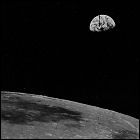 The Soviet Union launches Zond 8, the final Zond flight and the final flight of the Soyuz 7K-L1 capsule which was intended to be the command & service module of the Soviet manned lunar effort. Again, the vehicle orbits the moon and returns to Earth unmanned after a week in space. For only the second time, the 7K-L1 vehicle performs every phase of the flight flawlessly – though the Soviet Union, trying to downplay the space race, now retroactively denies that it was ever interested in sending men to the moon.
The Soviet Union launches Zond 8, the final Zond flight and the final flight of the Soyuz 7K-L1 capsule which was intended to be the command & service module of the Soviet manned lunar effort. Again, the vehicle orbits the moon and returns to Earth unmanned after a week in space. For only the second time, the 7K-L1 vehicle performs every phase of the flight flawlessly – though the Soviet Union, trying to downplay the space race, now retroactively denies that it was ever interested in sending men to the moon.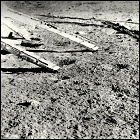 The Soviet Union launches unmanned space probe Luna 17 toward the moon, carrying with it the first automated moon rover, Lunokhod 1. Solar-powered and deployed to the surface via a pair of ramps, the wheeled rover operates for eleven months, more than double the expected operational life span. Unlike Luna 16, Luna 17 and Lunokhod perform their studies of the lunar surface without returning any soil samples to Earth.
The Soviet Union launches unmanned space probe Luna 17 toward the moon, carrying with it the first automated moon rover, Lunokhod 1. Solar-powered and deployed to the surface via a pair of ramps, the wheeled rover operates for eleven months, more than double the expected operational life span. Unlike Luna 16, Luna 17 and Lunokhod perform their studies of the lunar surface without returning any soil samples to Earth.